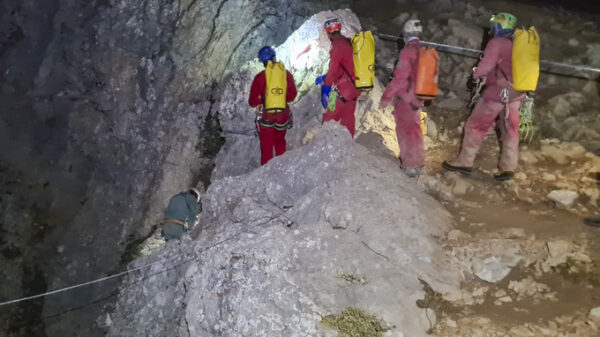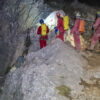OKUMA, Japan (AP) — At a small section of the Fukushima Daiichi nuclear plant’s central control room, the treated water transfer switch is on. A graph on a computer monitor nearby shows a steady decrease of water levels as treated radioactive wastewater is diluted and released into the Pacific Ocean.
In the coastal area of the plant, two seawater pumps are in action, gushing torrents of seawater through sky blue pipes into the big header where the treated water, which comes down through a much thinner black pipe from the hilltop tanks, is diluted hundreds of times before the release.
The sound of the treated and diluted radioactive water flowing into an underground secondary pool was heard from beneath the ground as media, including The Associated Press, toured the plant in northeastern Japan for the first time since the water release began.
“The best way to eliminate the contaminated water is to remove the melted fuel debris,” said Tokyo Electric Power Company Holdings spokesperson Kenichi Takahara, who escorted Sunday’s media tour for foreign media.
But Takahara said the scarcity of information from inside the nuclear reactors makes planning and development of the necessary robotic technology and a facility for the melted fuel removal extremely difficult.
“Removal of the melted fuel debris is not like we can just take it out and be finished,” he said.
The projected decades-long release of treated water has been strongly opposed by fishing groups and criticized by neighboring countries. China immediately banned imports of seafood from Japan in response. In Seoul, thousands of South Koreans rallied over the weekend to condemn the release, demanding Japan to keep it in tanks.
Japan’s Foreign Ministry on Sunday issued a travel advisory to Japanese citizens to use extra caution while in China. It said act of harassment, including massive phone calls, have targeted to the Japanese embassy, consulate and Japanese schools in China, and it urged Japanese in China to stay away from those places and from protests of the water release, and not to talk loudly in Japanese to avoid attention.
Managing the ever-growing volume of radioactive wastewater held in more than 1,000 tanks has been a safety risk and a burden since the plant was wrecked by a massive earthquake and tsunami on March 11, 2011. The tanks are already filled to 98% of their 1.37 million-ton capacity.
Releasing the water into the sea is a milestone for the decommissioning of the plant, which is expected to take decades. But it is just the beginning of the challenges ahead, such as the removal of the fatally radioactive melted fuel debris that remains in the three damaged reactors, a daunting task if ever accomplished.
The plant’s operator, Tokyo Electric Power Company Holdings, started releasing the first batch of 7,800 tons from 10 of the group B tanks, among the least radioactive water at the plant.
They say the water is treated and diluted to levels that are safer than international standards, and so far, testing by TEPCO and government agencies has found no detectable radioactivity in seawater and fish samples taken after the release.
The Japanese government and TEPCO say releasing the water is an unavoidable step in the decommissioning of the plant.
Since the earthquake and tsunami destroyed the plant’s cooling systems and caused three reactors to melt, highly contaminated cooling water applied to the damaged reactors has leaked continuously to the buildings’ basements and mixed with groundwater. Some water is recycled to cool the nuclear fuel, while the rest is stored in the tanks.
The release started at the daily pace of 460 tons and moves slowly. TEPCO plans to release 31,200 tons of treated water by the end of March 2024, which would empty only 10 tanks because the site will continue to produce radioactive water.
The pace will quicken later and about 1/3 of the tanks will be removed over the next 10 years, freeing up space for the plant’s decommissioning, said TEPCO executive Junichi Matsumoto, who is in charge of the treated water release. The water will be released over 30 years, but as long as melted fuel stays in the reactors, it requires cooling water under the current prospect.
About 880 tons of radioactive melted nuclear fuel remain inside the reactors. Robotic probes have provided some information but the status of the melted debris remains largely unknown, and the amount could be even larger, says Takahara, the TEPCO spokesman.
A trial removal of melted debris using a giant remote-controlled robotic arm is set to begin in Unit 2 later this year, though it will be a very small amount, Takahara said.
Spent fuel removal from the Unit 1 reactor’s cooling pool is set to start in 2027. The reactor top is still covered with debris from the explosion 12 years ago and needs to be cleaned up after putting a protective cover to contain radioactive dust.
Inside the worst-hit Unit 1, most of its reactor core melted and fell to the bottom of the primary containment chamber and possibly farther into the concrete basement. A robotic probe sent inside the Unit 1 primary containment chamber has found that its pedestal — the main supporting structure directly under its core — was extensively damaged.
Most of its thick concrete exterior was missing, exposing the internal steel reinforcement, prompting regulators to ask TEPCO to make risk assessment.
The government has stuck to its initial 30-to-40-year target for completing the decommissioning, without defining what that means. Rushing the schedule could cause more radiation exposure to workers and more environmental damage. Some experts say it would be impossible to remove all the melted fuel debris by 2051 and would take 50-100 years, if achieved at all.
Copyright 2021 Associated Press. All rights reserved.










































